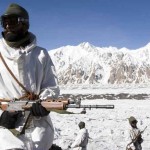Bewoor was worried by the hit-and-run raids of the Pakistani Air Force, particularly over the stretch from Khokhrapar to Nayachor. This area lay at the extreme range of our HF-24 aircraft operating from Uttarlai airfield, and a favourable situation was difficult to obtain till longer-range aircraft were diverted there for the purpose. These shortcomings were being brought home one by one by events, but they had completely escaped Bewoor’s attention in almost three years of joint planning. To learn from war was always costly, and Bewoor was slow to learn even then. A new operational instruction was issued to 11 Infantry Division:
- To speed up construction of the track, to organize generally administrative backing on a sound footing, and to build up for the impending attack in particular.
- To plan for the attack on the Nayachor defences by the night of 15/16 December if possible.
The latitude allowed in the Army Commander’s order by the phrase “if possible” indicated that Bewoor had some doubts about the feasibility of executing the operation by the stipulated time. The division had been in contact with the Nayachor defences from 8 December, but the Army Commander was not sure even by 16 December—after eight days of deliberation and waiting—that he would be able to attack. If this hesitation was due to the state of the track and its resultant inability to sustain administrative traffic, where lay the wisdom of inducting an additional brigade group from 12 Infantry Division into the sector?
| Editor’s Pick |
Meanwhile, the opposing Pakistani commanders were getting wiser. After watching the Indian failure to follow up the withdrawal from Longenwala and the subsequent dormancy in the Jaisalmer sector, they decided to reinforce Nayachor with one infantry brigade group from 33 Infantry Division, which arrived earlier than Bewoor’s sluggish moves could materialize. At this stage, Bewoor also ordered the move of the command reserve battalion with the anti-tank guided missiles squadron to the Kutch sector.
13 December
The Parbat Ali feature in the Barmer sector was attacked by the leading brigade group at 0300 hours in a silent attack along an expected approach and achieved a complete surprise. The enemy was caught almost sleeping and did not fire till the assaulting troops were about 90 to 180 metres away. Hand-to-hand fighting ensued and resulted in the enemy leaving 57 dead and 35 prisoners of war. The feature was firmly in Indian hands by 1100 hours and withstood three determined counterattacks and successive air strikes throughout the day.
The brigade in contact with the Nayachor defences in the Barmer sector had carried out patrolling at night and was able to establish that the front was held by approximately two battalions of the enemy.
The credit for this unorthodox attack and the resultant success goes to Brig Gurjeet Singh Randhawa, who did not follow Bewoor’s professional line of set-piece frontal attacks. Identification revealed that the feature was held by two subunits of two different units. It appears that the feature was on the inter-battalion boundary of the two battalions or was occupied by an ad hoc force. Hence the lack of cohesiveness in the fighting on it.
The scope of the firm base brigade group operations in the southern sub-sector was enhanced by Anand to include the development of a thrust towards Umarkot from the direction of Chachro. This brigade group was originally to hand over the sub-sector to the paramilitary force and pull out to participate in the divisional attack on Nayachor. As it was, Anand was finding it difficult to support administratively his two brigades opposite Nayachor along a single desert track, and the duckboard track was taking long to catch up.
The Army Commander was not happy about this departure from his plans, but Anand thought it prudent to use this brigade in a better way rather than to have a formation sitting in the Munabao-Gadra Road area doing nothing. In any event, the Umarkot operations directly affected his attack on Nayachor and would be of help. Anand stuck to his decision, and to implement it one battalion group advanced from Chachro.
14 December
After consolidating the Parbat Ali feature, further probing went on to fix the flanks of the Nayachor defences in the Barmer sector. The battalion group in the southern sub-sector made slow progress towards Umarkot through sandy stretches, where wheeled vehicles got stuck without encountering enemy opposition.
15 December
There was an engagement between the Pakistani Nayachor defences and one of the units on a probing mission in the Barmer sector. We suffered on officer and five other ranks killed and fiver officers and 26 other ranks wounded. This resulted in greater caution about further probings. BSF continued to be aggressive in Kutch. From Virawah operations were developed towards Date jo-God, and in the process a few more posts were occupied.
The leaders of the commando group reported that local intelligence revealed no suitable tracks for infiltration from southwest of Rahim-ki-Bazar towards badin. Bewoor accordingly changed their takes to raids on Islamkot on the night of 16/17 December. It was apparent that the command had no master plan for commando tasks and these were being thought of on the spur of the moment.





